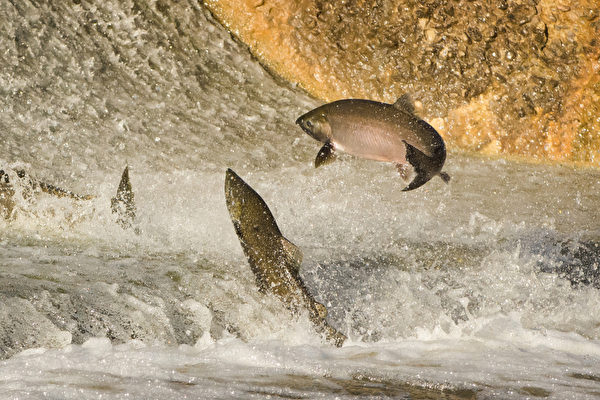A recent study indicates that when young salmon are contaminated by anti-anxiety drugs in the water, they are more likely to exhibit adventurous behavior during their migration, such as bravely venturing ahead and breaking away from the group.
The research conducted by Swedish scientists focuses on a drug called chlordiazepoxide, which contaminates many rivers, highlighting the widespread impact of drugs on nature. Researchers are calling for increased efforts to prevent drug contamination and urging individuals to responsibly dispose of unused medications.
In this study, researchers injected young Atlantic salmon with a dose of chlordiazepoxide, a benzodiazepine drug used to treat epilepsy and anxiety disorders, commonly found in wastewater. The dosage given to the fish was equivalent to what some fish may naturally encounter in streams. These young fish were then released into the River Dal in Sweden, where researchers tracked their migration to the Baltic Sea. These juvenile salmon were migrating to the ocean for the first time.
“We exposed different groups of salmon juveniles to varying concentrations or no exposure to any chemicals and found that it affects their migration to the Baltic Sea,” said Dr. Michael Bertram, assistant professor at the Swedish University of Agricultural Sciences and one of the authors of the study.
After exposure to chlordiazepoxide, more young salmon were able to complete the journey to the sea, moving faster through two dams along the way. Researchers believe this may be due to a decrease in the schooling behavior of the young salmon.
Laboratory experiments confirmed that chlordiazepoxide can reduce schooling behavior. However, researchers noted that a decrease in schooling behavior may increase the risk of individuals being preyed upon.
Although chlordiazepoxide was deliberately used in the study, its presence in waterways means that the concentrations are similar to what these fish may encounter in their natural environment.
In a paper published in the journal Science on Thursday, the researchers wrote, “These results suggest that ingesting chlordiazepoxide may alter the adventurous behavior of young salmon.”
“In summary, our research findings indicate that compared to conspecifics not exposed to chlordiazepoxide, juveniles exposed to chlordiazepoxide may adopt more adventurous and solitary strategies during their migration to the sea.”
The researchers expressed concern that fish consuming chlordiazepoxide are less likely to school, a survival strategy against predators. Therefore, while the “medicated” salmon may appear better at navigating rivers and less likely to be eaten during their migration to the sea, they may also be more vulnerable to perishing at sea.
Though it remains unclear how chlordiazepoxide exactly shapes salmon populations, this drug is impacting the complex behaviors of a species and the relationships within fish populations in the millennia-old food web. This alone is cause for concern, as it signifies another way in which humans are interfering with nature. And chlordiazepoxide is just one of thousands of prescription drugs worldwide.
The life of Atlantic salmon is extraordinary. They are born in freshwater streams, undergo physiological changes in their youth, and eventually migrate to the salty ocean, a journey that can span thousands of miles. After living at sea for a year or more, they swim upstream—typically returning to the river where they were born to spawn the next generation of salmon.
This journey is fraught with challenges, as they navigate through predator-filled rivers.
Another lead author of the study, researcher Jack Brand from the Swedish University of Agricultural Sciences, noted, “These drugs can be used as stress-relieving medications for humans.”
“You can imagine passing through hydroelectric dam reservoirs—which are large dams equipped with giant turbines—is quite stressful for small fish. You often find many predators lurking around these areas. Perhaps these drugs help fish recover from stress more quickly,” Brand explained.
Researchers worry that fish taking chlordiazepoxide are less likely to shoal, a predator-evasive behavior. Therefore, even though the medicated salmon may appear more adept at navigating rivers and less likely to be eaten on their way to the sea, they may also be more prone to perishing at sea.
While the exact impact of chlordiazepoxide on salmon populations remains unclear, this drug is affecting the intricate behaviors of a species and the dynamics within fish populations in the food chain that has been in balance for millennia. This alone triggers concerns, as it represents another way in which humans are interfering with nature. And chlordiazepoxide is just one of the thousands of prescription drugs globally.
(This article was referenced from a report on Vox website.)

